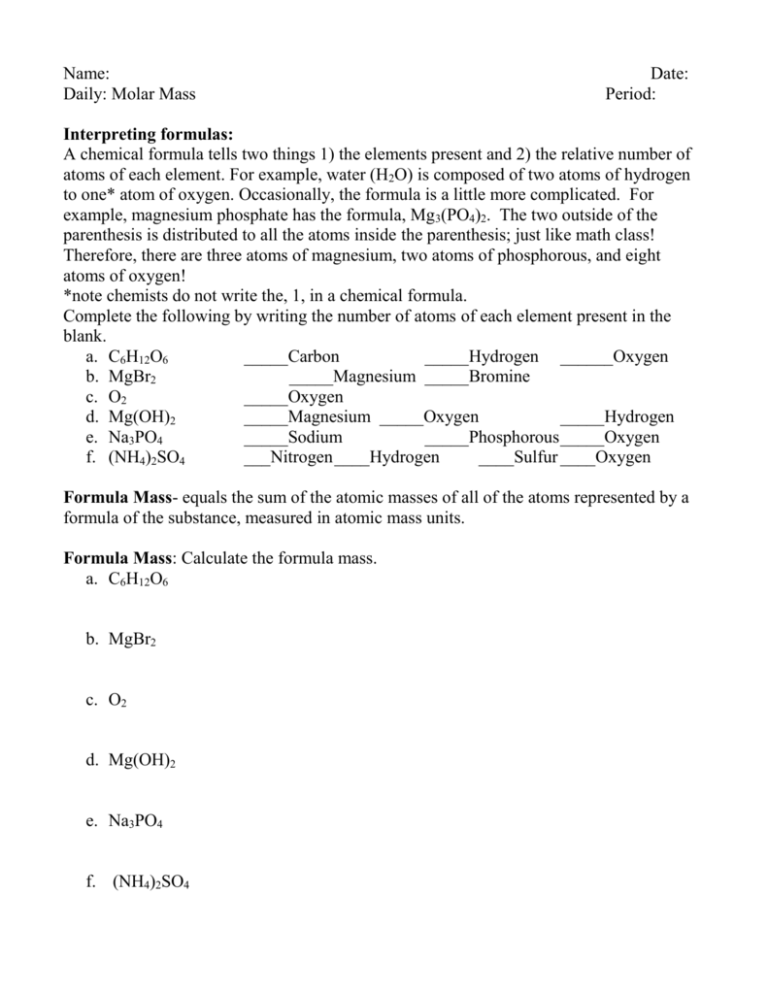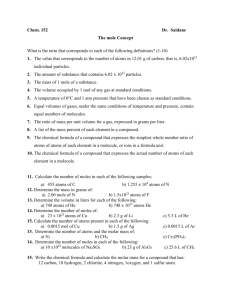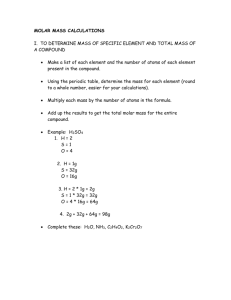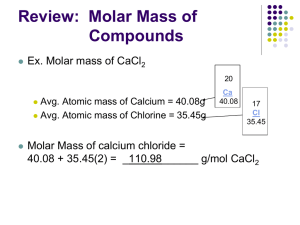Atoms/ Molecules/ Mole / Molar Mass Practice
advertisement

Name: Daily: Molar Mass Date: Period: Interpreting formulas: A chemical formula tells two things 1) the elements present and 2) the relative number of atoms of each element. For example, water (H2O) is composed of two atoms of hydrogen to one* atom of oxygen. Occasionally, the formula is a little more complicated. For example, magnesium phosphate has the formula, Mg3(PO4)2. The two outside of the parenthesis is distributed to all the atoms inside the parenthesis; just like math class! Therefore, there are three atoms of magnesium, two atoms of phosphorous, and eight atoms of oxygen! *note chemists do not write the, 1, in a chemical formula. Complete the following by writing the number of atoms of each element present in the blank. a. C6H12O6 _____Carbon _____Hydrogen ______Oxygen b. MgBr2 _____Magnesium _____Bromine c. O2 _____Oxygen d. Mg(OH)2 _____Magnesium _____Oxygen _____Hydrogen e. Na3PO4 _____Sodium _____Phosphorous _____Oxygen f. (NH4)2SO4 ___Nitrogen ____Hydrogen ____Sulfur ____Oxygen Formula Mass- equals the sum of the atomic masses of all of the atoms represented by a formula of the substance, measured in atomic mass units. Formula Mass: Calculate the formula mass. a. C6H12O6 b. MgBr2 c. O2 d. Mg(OH)2 e. Na3PO4 f. (NH4)2SO4 Molar Mass- The mass, in grams, of one mole of the compound. Molar mass is also referred to as molecular weight. Molar Mass: write the molar mass of the following. a. C6H12O6______________ b. MgBr2___________ c. O2_____________ d. Mg(OH)2____________ e. Na3PO4___________ f. (NH4)2SO4___________ g. Cu_________ h. Al_________ I. Mg_________ Mole- the SI unit for amount of substance; it is abbreviated mol. The mole is equal to 6.022 x 1023 atoms/molecules and is equal to, in grams, the molar mass of a substance. The number 6.022 x 1023 is known as Avogadro’s number (N). At standard temperature and pressure, 1 atmosphere / 273.15 kelvin, a mole of gas is equal to 22.4 dm3. The mole is abbreviated, mol. The Mole: Is the mole small or large? Why? 1. A dozen pencils equals ________ pencils. a. A foot equals ________inches. b. An hour equals ________minutes. c. A pair of socks _______socks. d. A mole equals __________ atoms. e. A mole equals ___________liters. 2. Two dozen cookies equals _________cookies. a. Three hours equals _______minutes. b. Two moles ____________atoms. c. Three moles____________ molecules. Stoichiometry- The study of quantitative relationships that can be derived from chemical formulas and equations. Moles to Atoms 2.1 moles of Na =_______________atoms Na Atoms of Moles 4.0 x 1024 atoms of Al =_____________molAl 4.8 moles of Be =______________atoms Be 2.1 x 1023 atoms of Cu = __________molCu 9.0 moles of Rb = ___________moles Rb 8.1 x 1024 atoms of K = ___________molK 5.2 moles of W = _______________atoms W 8.4 x 1024 atoms of Cr =____________molCr Moles to Volume Volume to Mole 1 mole of Kr = ___________LK 44.8 L of Xe = __________mol Xe 7.2 moles of He =____________LHe 18 L of H =__________mol H 4.8 moles of Ar = ___________LAr 105 L of Br2 =__________mol Br2 8.2 mole Ne = __________LNe 18 L of O2 = ________mol O2 Moles to Mass 3.7 moles of Fe =____________g Fe Mass to Moles 52.90 g of Si =__________________mol Si 8.2 moles of Ni = ___________g Ni 73.2 g of As = ___________mol As 8.2 moles C =_____________g C 82.0 g of Mg = ________________mol Ca. 3 moles of Al =_____________g Al Mass to Atoms 25.45 g of S = _________atoms of S 105 g of Au = _________atoms of Au 18 g of Ag =__________ atoms of Ag 109 g of Hg = __________atoms of Hg 54.3 g of N =_______________mol N Atoms to Mass 4.2 x 1023 atoms of Pb = ___________ g of Pb 8.2 x 1024 atoms of Zn = ___________g of Zn 1.8 x 1023 atoms of P = ___________g of P 4.5 x 1023 atoms of B = __________g of B Mixed Problems 1. 18 grams of cobalt = _________atoms Co 2. 9 mol of barium = ___________ g of Ba 3. 6.0 x 1021 atoms of magnesium = ________g Mg 4. 9.02 x 1023 atoms of lead =___________mol Pb 5. 25.3 g of lithium =_________mol Li 6. 18 mol of mercury = _________atoms of Hg 7. 24.3 L of Neon = _________moles of Neon Even more practice!!! 1. Juglone, a dye used for centuries, is produced from the husks of black walnuts. Juglone has the formula, C10H6O3. Calculate the molecular mass of Juglone. B. If you have 500 grams of the dye, how many molecules are present? 2. Calcium carbonate (CaCO3) is the principal compound found in chalk. Calculate the molar mass of calcium carbonate. B. If you have 2 moles of calcium carbonate, what is the mass of the sample? 3. Ascorbic acid (vitamin C) is an essential vitamin. What is the molar mass of ascorbic acid (C6H8O6)? B. If you have 6.07 x 1024 molecules, what is the mass of the ascorbic acid sample? 4. What is the molar mass of aspirin (C9H8O4)? B. If you have 100 grams of aspirin, how many moles are present? 5. Calculate the molar mass of water (H2O). B. If you have 12.7 L of water vapor, how many molecules are present? 6. Calculate the molar mass for potassium permanganate (KMnO4). B. If you have 1.2 moles of potassium permanganate, what is the mass of your sample?







